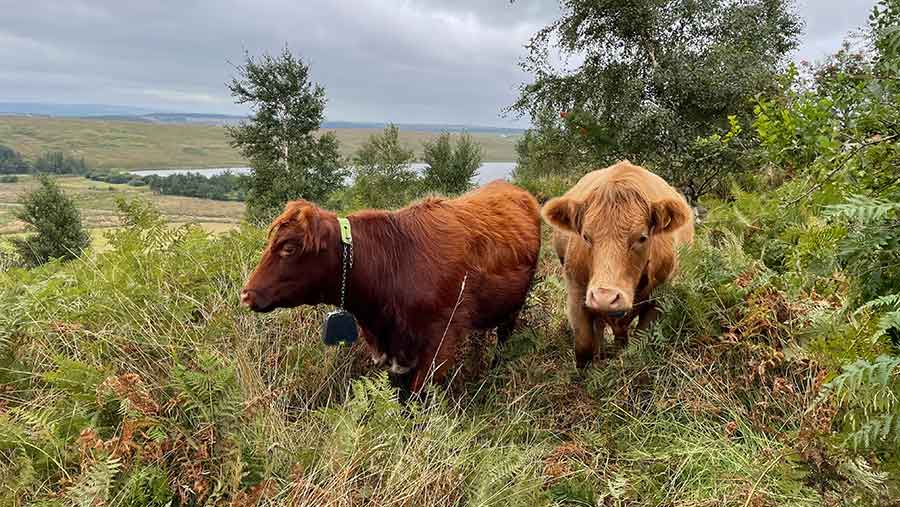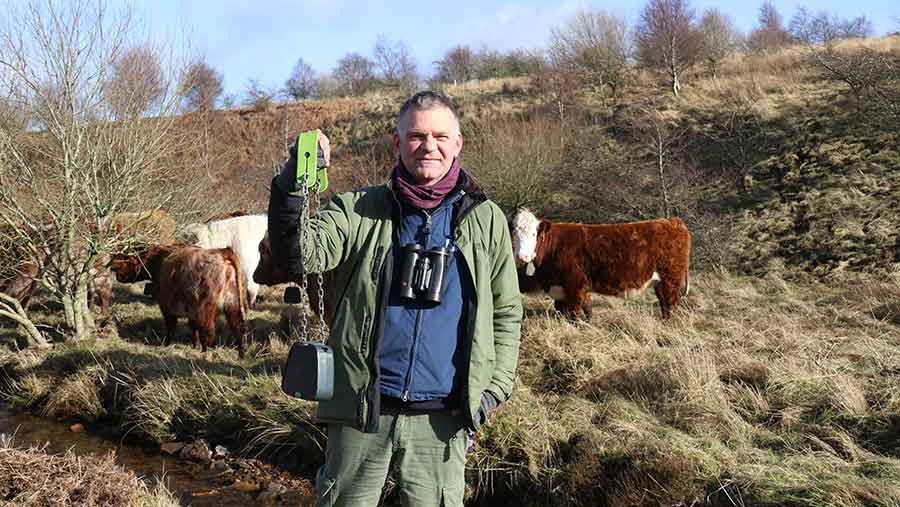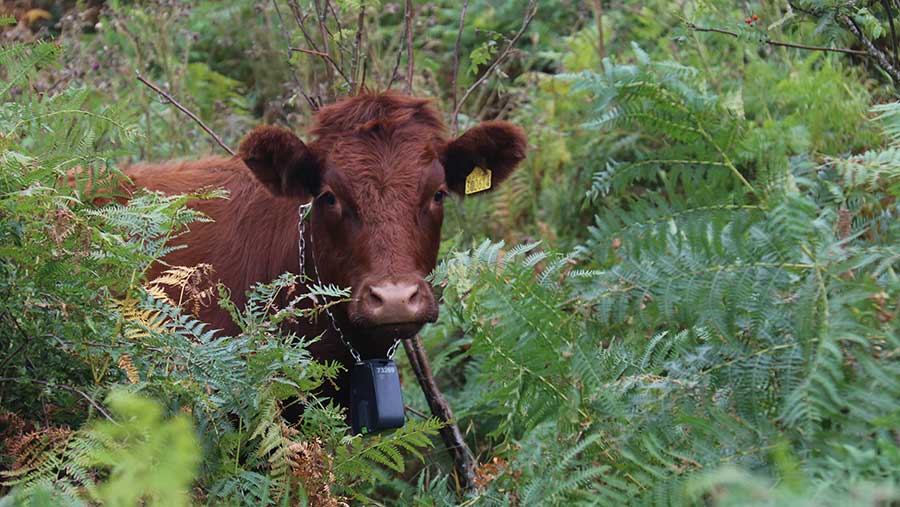Advertiser content
Virtual fencing benefits conservation and commercial farming goals
As more interest develops in conservation and commercial farming sectors to improve ecosystems and increase upland utilisation, cattle are becoming a favoured tool for both parties to meet both environmental and farming business goals.
According to Ian Ryding, farmland warden at Geltsdale RSPB Nature Reserve in Cumbria, cattle are the ideal tool for conservation grazing and ecosystem restoration.
See more: Benefits of switching cattle to cattle and virtual fencing
“Unlike sheep, cattle aren’t as selective when it comes to grazing and do a really good job at browsing coarse vegetation while also breaking it down.
“Not only does this create better growing conditions for other grasses and wildflowers to grow and thrive, but it also creates a brilliant habitat for birds.
“Cattle are really good at spreading seed around via their dung, whether that’s tree, grass or flower seed, which further advances biodiversity,” says Ian.
“And at the end of it all, cattle go on to be a high-quality, premium food product that was sustainably raised on land that is otherwise difficult to farm. It is a win-win.”
Overcome infrastructure and management challenges
While the benefits of grazing cattle in uplands are many, so are the challenges.
Fencing and effective grazing management within large and small sections of upland or scrubby environments have long kept conservationists and farmers from being able to effectively utilise cattle in such areas.
“The cost alone to physically fence upland areas makes it unfeasible, let alone the practicalities of moving large sections of temporary fence to effectively manage upland grazing – be that for ecosystem management or pure utilisation capacity purposes,” says John Smout, sales manager for Nofence UK.
Founded in 2011 by a mountain grazer in Norway, Nofence entered the UK market in 2021 following two years of trial work on commercial beef farms in England.
The technology has been a game-changer for conservationists and intensive livestock operations alike by removing the barriers physical fencing limitations put on grazing management.
Through a combination of GPS, cellular communication and audio signals, Nofence virtual fencing works with animal behaviour to create a virtual fencing perimeter that can be monitored and changed with a smartphone app.
Once livestock are turned out on the virtual pasture while wearing a Nofence collar, GPS and a mobile data network track the animal’s location and report back to the app, triggering the collar to cue an audio signal as the animal nears the virtual fence boundary.
If the animal continues to move forward it will receive an electric pulse. Animals can return to pasture without receiving any audio warnings or pulses.

© Nofence
“Instead of cows using their sense of sight to see a physical fence to keep them in, they use their sense of hearing. And it has proven to be very effective,” explains John.
“Through observations of herd behaviour from more than 72,000 collars logging more than 440m grazing hours on pasture, a typical farm will have just one pulse per every 30 audio cues.
“The app allows farmers to track the number and location of audio signals and pulses given to individual animals to allow them to adjust pasture design if required.”
Trial work has also found there to be no noticeable differences in cattle faecal cortisol levels, observed behaviour and daily liveweight gain when comparing virtually fenced cattle to those electrically fenced.
See more: Highland farm grazes cattle unfenced with GPS collars
Aside from setting virtual pastures, Nofence features also include the ability to create exclusion zones within paddocks, track livestock location and movement history, and analyse grazing heat maps to better understand utilisation within a specific area.
The collars are also engineered with solar panels, allowing cattle to graze for months at a time without battery recharges.
Ecological benefits
Of that, 240 hectares have been established with trees and scrub as part of a woodland development project.
From 2003 to 2004, the woodland plantation was planted to 110,000 native trees, with species including alder, birch, hawthorn, rowan and sessile oak.
Following the woodland’s maturity to be able to withstand grazing, Ian split the block into 50 to 60-hectare sections for the start of grazing with the first 19 Nofence collars in 2020.
Cattle were brought in partnership with a commercial beef farmer whose crossbred herd consists of Luing, Highland and Beef Shorthorn genetics.
A recent 90 hectares of woodland being ready for grazing has seen the Nofence collars increase to 27 in total.
According to Ian, Nofence has allowed the reserve to improve the woodland habitat while also protecting ground-nesting bird populations and reserve infrastructure.

Ian Ryding © Nofence
“Cattle grazing in these established woodland areas creates a very interesting and brilliant habitat for birds that is quite open and scrubby.
“From its inception, we wanted this to be woodland pasture, the ancient practice in Britain by grazing livestock in woodlands,” says Ian.
Both the cattle herd and the woodland have benefited.
The trees and scrub provide cattle with a hugely varied diet which benefits rumen health and in return, they increase biodiversity by opening up the habitat and spreading seed with their dung.
The trees also provide shelter from the elements and mental stimulation for the cows.
“Instead of letting cattle have free reign of the entire 240 hectares, which is a large area for a small herd of cows, Nofence has allowed us to condense grazing into smaller compartments that allow us to optimise the grazing within,” says Ian.
“It also allows us to protect reserve infrastructure by keeping cattle off of visitor trails and out of springs which feed into the water supply for multiple cottages on the site.”

© Nofence
See more: How a beef farm manages environmentally sensitive grazing
This extends over to habitat protection, with the reserve being home to a large population of ground-nesting birds. Primary bird species at Geltsdale include Black Grouse, Curlew, Lapwing and Whinchat.
Using surveys to identify areas of high nest populations, Nofence can be used to virtually fence off these areas and to set up exclusion zones to protect nests within grazing blocks.
“The majority of our bird species nest on the ground, making them very vulnerable to farming operations. One of the things we can do using Nofence is to avoid cattle trampling those nests by setting up exclusion zones.
“This has worked out well and is far more feasible to manage and also more economical than if we were to do this with an electric fence,” says Ian.
Improving working relationships between farmers and conservationists
According to John, Nofence has proven to be an effective tool for improving the working relationships between farmers and conservationists by allowing both parties to monitor cattle location and movement via the app.
“There’s a lot to be gained for farmers by working with local conservation groups to use their cattle for projects.
“Different functions of the Nofence app can foster positive working relationships by keeping both parties on the same page,” explains John.
Using the Nofence app, farmers can check the real-time location of individual cattle which allows them to quickly do their daily in-person checks.
App users can monitor the amount of audio signals and pulses issued, allowing for virtual fencing reconfigurations if necessary.
They will also receive a push notification if an animal escapes and the real-time location of it so they know if they have returned to the herd or if they need to go move them.
See more: Talking about dogs-and-wildlife link on SSSI heathland
Nofence has received a lot of positive feedback from joint conservation-farming relationships working more smoothly by improving communication. RSPB Geltsdale has been no different.
“Conservation relies on grazing animals and working alongside the farming community who provide them,” concludes Ian.
“There’s so much to be gained by working together to benefit from resources and the expertise that we can provide each other with.
“This technology has helped foster good working relationships, is improving communications as well as helping to achieve some common goals.”
Provided by
Nofence is the world’s first commercial virtual fencing solution for livestock, where the animals are controlled by GPS collars and an app.
